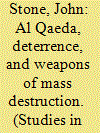| Srl | Item |
| 1 |
ID:
091063


|
|
|
|
|
| Publication |
2009.
|
| Summary/Abstract |
This article takes issue with the frequently-made assertion that Al Qaeda cannot be deterred from employing weapons of mass destruction. It argues that Al Qaeda's leadership employs terroristic violence in a manner calculated to achieve a set of political goals. They are, in other words, rational actors who are sensitive to the potential costs and benefits associated with their actions, and thus are to some extent deterrable. The article examines a number of ways in which the lack of discrimination and proportionality associated with weapons of mass destruction might be expected to produce more problems than benefits for Al Qaeda and thus deter their use. It also considers some ways in which the West might seek to bolster these deterrent effects.
|
|
|
|
|
|
|
|
|
|
|
|
|
|
|
|
| 2 |
ID:
091065


|
|
|
|
|
| Publication |
2009.
|
| Summary/Abstract |
Recent Al Qaeda threats and related jihadi propaganda potentially herald a new weapon in the terrorist arsenal: the deliberate setting of forest fires and other conflagrations both to terrorize society and wreck untold economic damage. Beyond the immense, new burdens that would be placed on emergency response personnel, these fires could also create grave environmental crises causing severe pollution from gases escaping into the atmosphere. The strategy of "Forest Jihad," now being championed by Al Qaeda strategists, is supported and justified theologically by radical Islamic scholars. With this new weapon, the terrorists believe, maximum physical and financial damage can be inflicted to targeted countries at comparatively little risk.
|
|
|
|
|
|
|
|
|
|
|
|
|
|
|
|
| 3 |
ID:
091066


|
|
|
|
|
| Publication |
2009.
|
| Summary/Abstract |
Although the psychology of terrorism is far from a neglected subject, there is still much to learn. "Ordinary" criminals remain enigmatic but have proved a far more accessible population for research purposes. This article bridges the gap between the study of crime and contemporary terrorism by examining the parallels between the two. Significant similarities are shown to exist between terrorists and organized as well as low-level criminals, including activities performed and systems of social influence and organization. Processes of social identification are universally important to varying degrees; however, specific differences in identity may represent key distinguishing features between groups. Although further comparisons utilizing more restrictive samples are necessary, attention is drawn to the sometimes underutilized potential that criminological research holds to act as a point of reference for the investigation of terrorism.
|
|
|
|
|
|
|
|
|
|
|
|
|
|
|
|
| 4 |
ID:
091068


|
|
|
|
|
| Publication |
2009.
|
| Summary/Abstract |
The global counterinsurgency strategy to combat terrorism emphasizes responding to the social and economic needs of communities where terrorists may find support. Public opinion data can help in that strategy, as shown by a 2006 survey of 1,200 young males from three provinces in Russia's North Caucasus. Conventional wisdom notwithstanding, the survey shows few signs of burgeoning radical Islam or ethnic animosity. Instead, economic conditions and poor governance are primary concerns. The region provides both an opportunity and threat: policymakers can and should address the region's needs; if not, radical Islamist groups can turn it into a flashpoint for terrorism.
|
|
|
|
|
|
|
|
|
|
|
|
|
|
|
|
| 5 |
ID:
091064


|
|
|
|
|
| Publication |
2009.
|
| Summary/Abstract |
This article was written at the request of the Secretary of Defense Task Force on DoD Nuclear Weapons Management. While this analysis suggests that certain types of terrorists can be deterred from certain types of attacks, it is less optimistic about the use of nuclear weapons in a terrorist deterrent strategy. A broad approach to deterrence may be effective against certain types of terrorist groups and attacks, making it crucially important to disaggregate the terrorist threat when setting policy. The article goes on to address two types of terrorist groups with a "global reach" that pose a serious threat to the United States: non-state actors driven by doctrines permitting catastrophic attacks and state-sponsored groups capable of carrying out catastrophic attacks. The analysis reveals a number of previously unappreciated tradeoffs and paradoxes associated with the deterrence of terrorists.
|
|
|
|
|
|
|
|
|
|
|
|
|
|
|
|